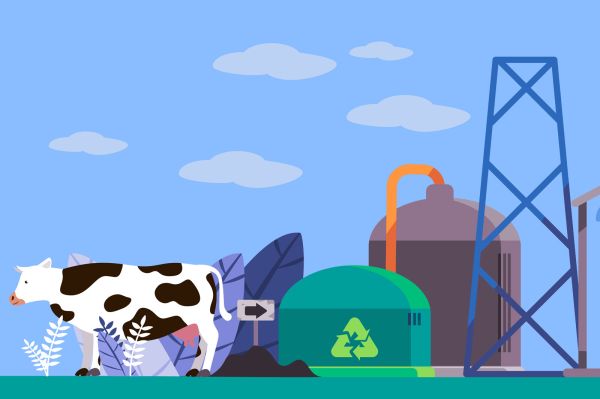‘Where there’s muck, there’s money’

The old adage, ‘where there’s muck, there’s money’ certainly seems to apply to biomethane production, if the large attendance at the recent biomethane conference held at Croke Park is any indication. A cross-section of interested parties, including would-be developers, financiers, co-op representatives, researchers, advisors and farmers received a comprehensive appraisal of how a biomethane industry at scale could reduce greenhouse gas (GHG) emissions, substitute imported energy requirements, deliver a profitable alternative to existing farm enterprises; and secure a new, long-term industry for rural Ireland.
Growth potential
While biomethane production is commonplace across Europe, it is very much in its infancy in Ireland. The potential for further growth in the sector in a European context, as well as the development of a viable industry in Ireland, was well outlined. Currently, in the EU, anaerobic digestion accounts for 3.4 billion cubic metres of output. By 2030 it is anticipated that the production figure will rise to 38 billion cubic metres. Rising by another 30 billion cubic metres by 2040, continued growth in production could see up to 90 billion cubic metres being produced within the EU by 2050. Translating that into gas output, biomethane production could supply 85 per cent of Europe’s gas needs by 2040. If delivered, that would provide enormous energy security for Europe, while also delivering on energy sustainability requirements and building an industry of scale and value.
Wide-ranging benefits
The benefits of large-scale biomethane production do not end there, as the Croke Park conference attendees were reassured. The digestate from the production system could provide an alternative to the use of synthetic or chemical fertilisers. With 31 million tonnes of digestate dry matter being produced annually in Europe already, that is sufficient to displace 15 per cent of nitrogen-based fertiliser. The nitrogen demand across the EU is running in the region of 22 million tonnes per year so a 15 per cent substitution rate delivers a not-insignificant alternative source for 3.3 million tonnes of synthetic nitrogenous fertiliser.
Phosphorous fertiliser substitution is in the order of 11 per cent, with total demand estimated at 2.8 million tonnes annually, while 3.1 million tonnes of potassium fertiliser are used in the EU each year and figures produced at the biomethane conference stated that biomethane digestate currently replaces 6 per cent of that demand. All of that adds up to a significant reduction in GHG production of 10 million tonnes of CO2 equivalent, as calculated for 2022.
Natural, or fossilised, gas is the main ingredient in the production of synthetic fertilisers, so the replacement of 15 per cent of that synthetic fertiliser requirement with biomethane digestate could save two billion cubic metres of that finite natural gas. There is another major substitute opportunity in the form of CO2 production. As well as an important environmental gas, it is also used in industrial processes including food packaging. Biomethane production units produce CO2 in addition to methane. The capture and use of biogenic CO2, as it is termed, can offset CO2 emissions to the atmosphere, another valuable contribution to climate change mitigation measures.

Pictured at Ireland Biomethane – Pathway to 2030: PJ McCarthy, CEO, RGFI; Dr Anne Marie Henihan, centre director, Dairy Processing Technology Centre; JP Prendergast, chair, RGFI; and Denis Drennan, president, ICMSA. Photo: Jason Clarke.
Alternative energy supply
For the Irish economy, specifically, the establishment of a viable biomethane industry has significant benefits, as discussed at the conference. Ireland’s current gas demand is running at 57 TerraWatt hours (TWh) and 75 per cent of that gas is imported. We still have significant supply from the Corrib Gas Field, but that will diminish quickly in the coming years, with no other potential sources being explored. That is mainly a result of Government policy, which is not encouraging oil or gas exploration, even though it is believed that there are large oil and gas deposits in the Barryroe Field off the south Cork coast. Current biomethane production in Ireland accounts for 0.001 per cent of our gas demand. The Government target is to increase that figure to 1 TWh by the end of next year, rising to 5.7 TWh by 2030. That would represent a significant, though not a transformative, reduction in our energy import requirements. The reality is that the development of a new natural gas field such as Barryroe, if its promise were to be fulfilled, at the scale of the existing Corrib Field, would deliver far more energy at far lower cost than biomethane production. The optimum strategy would be the development of both sources, delivering cost-effective energy to the Irish economy with a high degree of energy security, an increasing risk factor in a volatile world.
Impressive ambition
Nevertheless, the scale of ambition for Irish-produced biomethane is impressive. Working from what is described as an ‘agri-centric strategy’, the intention is to utilise up to 120,000 hectares of grass silage as well as large volumes of animal slurry to fuel up to 200 new biodigester plants. This, in turn, would result in the creation of 3,000 new jobs, mostly in rural Ireland. The strategy refers to supplying feedstock for these plants and the utilisation of digestate, and not specifically to active downstream involvement of farmers and landowners in this new industry. That is why it is so important, from a farmer perspective, that structures are developed to allow farmers to actively participate in the nascent biomethane industry over and above being providers of raw materials to fuel the plants and recipients of the residue after gas extraction. The real action, in terms of profits and return on investment comes from active involvement and ownership of the assets involved. The commitment of the co-op sector to develop a series of large-scale biodigesters across the country offers one access route for farmers and landowners to participate more fully in this new energy production industry.
Enabling requirements
While biodigester technology is well developed and relatively simple to construct, there are several critical enabling requirements to be developed before it can deliver on its potential in Ireland. The first requirement is that it is an industry that is acceptable to those living in proximity to the proposed plants. We have seen much opposition to wind turbines around the country. Solar farm installations are now becoming a matter of contention in some rural communities. It must be taken for granted that biodigester plants will be a cause of concern, over safety, odour and transport infrastructure overload. Whether these concerns are well-founded or not is immaterial. They will have to be actively addressed. Other practical requirements include ease of grid access, whether through direct pipelines or by road transport to access points. The marketing of this gas is another issue. Talk of mandatory inclusion in existing fuel mixes must translate into policy and legislation if a viable, long-term market is to be established. Ultimately, consumers, householders, businesses and large industries will have to accept that they will face higher energy costs, given the current cost of natural gas, versus the much higher cost of turning muck (grass and slurry) into money (gas).




